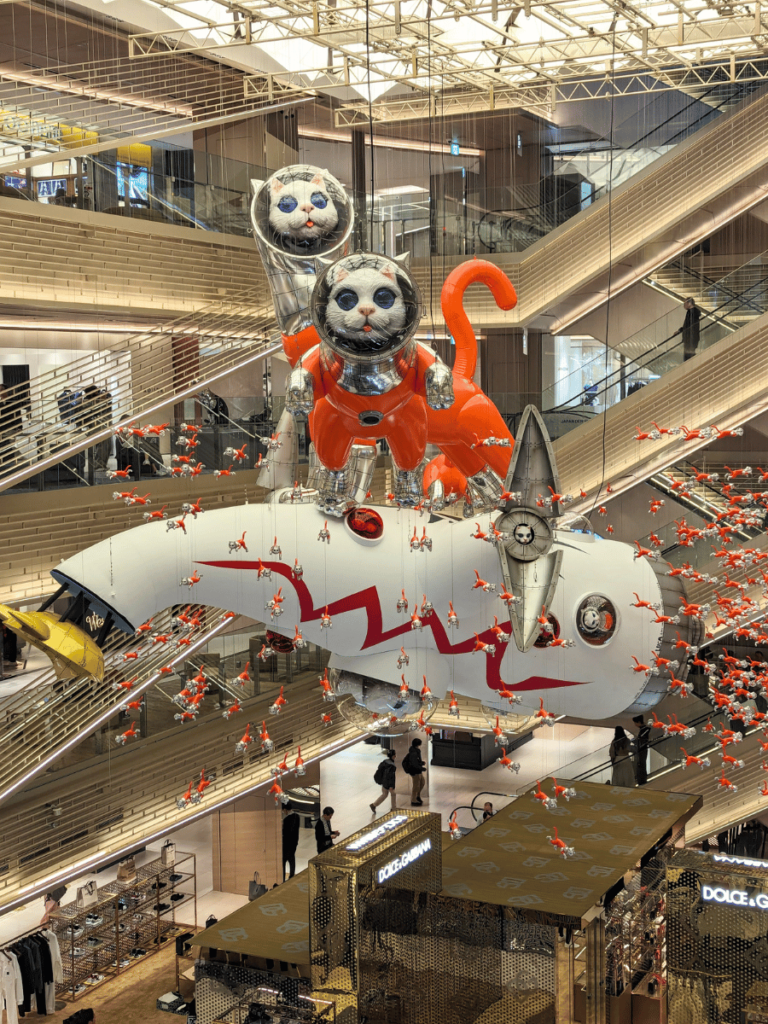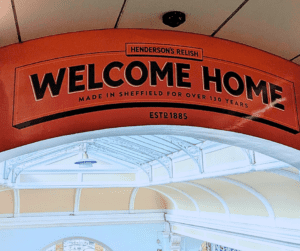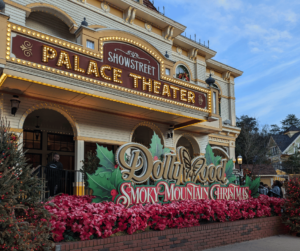April 2024: What Japan taught me about retail experiences

Anyone who’s been anywhere near me in the past few months will know in April I was heading for Japan. I apologise if I went on about it a bit, but it was such a big trip for me and I was both anxious and excited for it.
I won’t use this space to enthuse (too much) about my trip, but I did come away with some insights into how shopping in Japan, and there are definitely learnings that I think the UK high street could implement. If it was as much fun shopping here as it was in Japan I reckon we could encourage more people to leave their laptops and head to the shops in person.
Shopping as a national pastime
Shopping is a big thing in Japan; there are a staggering number of department stores, malls, and unique shops. I never had to worry about finding a corner shop for refreshments as, no matter where we were, there was always a conbini (convenience store).
I’d go so far as to say Tokyo is one big shop; the whole city feels like a curated collection of specialised stores. There’s really something for everyone. with key shopping districts for different tastes: Ginza for luxury and high-end boutiques, Shibuya for youth culture and fashion, Harajuku for quirky stuff and street fashion, Akihabara for electronics. Each district is densely packed with a variety of shops, making the city feel like a continuous shopping experience.



The sounds of shopping in Japan
Generally being in Japan felt like I was existing in a real life video game and this had a lot to do with the sounds that accompany you in the cities.
When you travel on the subway in Tokyo you notice that many of the stations have their own unique jingle – an ingenious way of identifying where you are. These jingles are called “eki-melo”, which translates to “station melody” and reflect the character of the area. Tokyo even has a subway composer, Minoru Mukaiya, famous for creating they jingles for 110 of the city’s stations. I loved this feature of travelling on the train and I like to think how it could be applied to the Tyne & Wear metro. I wonder what the Percy Main jingle would sound like…
Many shops also have their own unique jingles, I am among many who love the Family Mart tune that’s become iconic in Japan. Known as the “Family Mart Jingle” ” this welcoming, five-note melody plays every time you enter or leave the store, which creates a sense of familiarity and consistency that gives you a warm feeling about this convenience store which I just don’t get when I pop into a Tesco Express.
Don Quijote, a ridiculously insane discount store, which deserves its own post, is a discount chain store famous for its loud, fast-paced jingle that instantly identifies the brand. The song “Miracle Shopping” , is an upbeat and lively tune that plays on loop inside the store effectively imprinting it into your brain so that you will never be able to forget it! The repetitive nature of the song makes it instantly recognisable and irritating, which aligns perfectly with this crazy shop’s brand.
This is just not something that you come across in the UK, but I think using sound and music can be very effective for brand recall and building customer loyalty; I mean, I’m not sure the Don Quijote earworm will ever leave my head.



In store shopping experiences
Many of the shops I visited were an experience in itself; I realise a lot of this was to do with everything being SO different, but I was also impressed at how beautifully curated many shops I went into were. The way the products were displayed with such care, often colour coordinated, it made exploring what was on offer a more joyful experience.
I was fortunate enough to be visiting during cherry blossom season and how this was incorporated into both displays and limited edition products was delightful. Japanese shops excel in incorporating elements like Instagrammable spaces, art installations, and innovative displays to make shopping more than just, well shopping. This approach not only enhances the shopping experience but also promotes social sharing and brand engagement. One notable example of this was Ginza Itoya, a seven floored stationery store in an architecturally designed building with each floor is curated around product type – the journal floor, pen floor, paper floor etc. As well as a vast array of products, Itoya offers workshops and customisation services, such as notebook binding and pen engraving. What I really liked about this shop was how it elevated everyday items to objects of beauty.
When in Tokyo I made a point of visiting the Ginza Six shopping complex just to see the Big Cat Bang installation by artist Kenji Yanobe; I love how they brought both art and entertainment directly into a department store. The installation featured astronaut cats soaring through a galaxy aka the shopping complex atrium. I came to see the art and naturally ended up browsing the shops when I was there. This is a great example of how creating an engaging shopping experience can draw in new customers and make an ordinary shopping trip more memorable.
I also visited Daimaru, one of Japan’s major department stores, in both Osaka and Kyoto and was impressed by the displays that were both Instagrammable and immersive. They used an imaginative approach to visual merchandising including a huge burger which of course we had to be photographed with, and of course it being Japan Studio Ghibli, Hello Kitty and Godzilla.


I can’t go without mentioning the Nintendo stores which we visited in both Kyoto and Tokyo which immerse you into the world of Nintendo from the moment you step through the door. They were more like a blend of shop and museum with the design featuring elements from games like Super Mario, The Legend of Zelda and Animal Crossing amongst others.
In Nintendo Kyoto there was even a rooftop space where you could get photos taken with character statues, and in themed areas. In store, I really liked the pick-and-mix display where you could fill a small container with as many tiny Nintendo themed erasers as you could fit inside – not sure what I’m going to do with them, but the container sits on my desk and makes me smile when I look at it.
Of course Nintendo is an iconic brand so these stores act not only as retail outlets but also as destinations for fans to celebrate their love for Nintendo’s games, and immerse themselves in an engaging and interactive environment. Nintendo’s shops demonstrate how retail can extend beyond transactions to become an integral part of a brand’s community and culture.
Here in the UK, I really feel that shops could do more to incorporate immersive displays and themed interiors to enhance customer engagement and make visits more memorable. I’d be more inclined to visit the shops in person if the expectation wasn’t purely focused on the transaction. There are some that are doing it well, Waterstones for example has had to give people a reason to visit their bookshop when their biggest competitor is Amazon. They integrate reading nooks and cafés within their stores as well as hosting live events and book signings. IKEA has always done it well with its immersive fully set-up rooms, providing inspiration and a tactile shopping experience where customers can interact with the furniture and envision how items might look in their own homes.I was also recently impressed with Loaf, the sofa shop, that has ‘slowrooms’ rather than showrooms that encourage you to test out the products in a no-rush atmosphere offering complimentary treats.
More of this type of stuff please!
Where the adverts are visitor attractions
There aren’t many countries I’ve visited where the marketing itself is a tourist attraction, but this is Japan and it offers numerous interactive and immersive experiences.
On our first night in Japan we walked from our hotel to the madness that is Dontonbori in Osaka. The neon lights and huge billboards here make it one of Osaka’s primary tourist attractions. Many of these billboard adverts use LED technology to display animated advertisements that only adds to the sensory overload – I’m not sure it helped my jet-lag!
The most iconic billboard in Dotonbori is the Glico Running Man, which depicts a runner crossing a finish line – it’s been a landmark of the area since it was installed in 1935 and represents the Glico confectionery company. Another famous 3D billboard in this area is the giant mechanical crab above the Kani Doraku restaurant which moves its arms and eyes – It’s not just an advertisement but an attraction in itself.
In Tokyo, you’ll find Shinjuku East Square’s 3D Calico Cat; a digital billboard featuring an ultra-realistic, giant 3D cat which is fascinating to watch. The billboard is a curved LED screen that displays an HD video of a huge cat which appears at certain times of day. It meows, stretches, and interacts with the passersby below. Again, the Shinjuku Cat Billboard is more than just an advertisement; it’s an example of how digital art and advertising can add to the cityscape and turn an ordinary billboard into a must-see destination.
One form of advertising that I found particularly irritating were the ad-vans that drove around, usually advertising J-pop bands. Yes, they captured attention, but they were noisy and disruptive – not something I’d like more of.
Here in the UK there’s great potential to use technology to both advertise and attract visitors. I know in London it’s more commonplace, but I’ve not seen much adoption across other cities I’ve visited. I’m not advocating adopting Japan’s extensive use of neon and LED lighting, but imaginative immersive outdoor media could act as a draw to city centres as well as an effective out-of-home (OOH) marketing technique.


Japanese Conbinis (Convenience stores)
Japanese conbinis (convenience stores) are a one-stop-shop for daily essentials, and have a well-deserved reputation for offering high-quality food that defies the typical expectations of convenience stores – many are open 24/7. There are three main conbinis in Japan: 7-Eleven, Lawson, and Family Mart. Each one has a reputation for different products: 7-Eleven is known for its good quality bento boxes and sandwiches, Lawson its baked goods and Family Mart its fried chicken.
Before I went to Japan, if you’d told me I’d have got my lunch and dinner from a 7-Eleven I wouldn’t have believed you, but that’s exactly what we did on more than one occasion. Unlike many Western convenience stores, conbinis in Japan provide fresh, tasty, and well-prepared food options, from bento boxes and sushi to freshly baked goods. Conbinis are a big part of Japanese daily life – with their good quality food and focus on efficiency, they’re a popular choice among busy professionals and students.
I think convenience stores in the UK are missing a trick by not offering quality fresh meals. In Japan I could buy a delicious, fresh noodle dish which would be heated up for me in-store there and then. I know there are sometimes microwaves in service station shops over here, but a heated Gingsters pasty doesn’t quite compare.
What I would love to see the UK adopt more of:
-
Enhancing In-store Experiences
UK retailers could look to develop more immersive and themed interiors that promote customer engagement and make shopping visits more enjoyable and memorable. -
Sound & Music
Integrating sound into branding, such as store-specific jingles, could enhance customer loyalty and brand recognition. -
Quality in Convenience
I wish our UK convenience stores were more Japanese, particularly by offering higher quality, fresh food options.
I think it’s about time I booked another trip (all in the name of research obviously).



